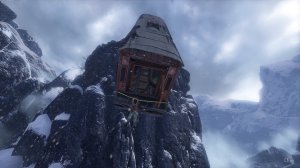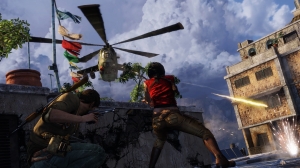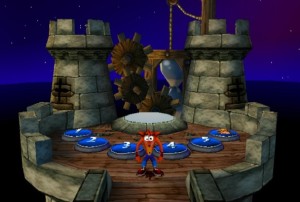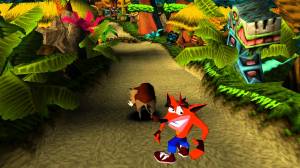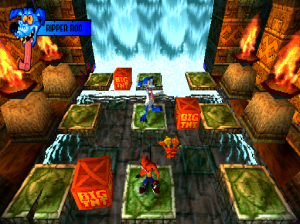These days, first-person shooters and other, more “mature” genres are the most prominent games. But back in the 1990s, it was all about cartoony platformers. Mario was the long-standing gaming icon, and Sonic the Hedgehog had risen to prominence in the early years of the decade. Sonic’s popularity lead to countless imitators, with many an “animal with attitude” failing to replicate what made the hedgehog Mario’s one-time rival. There was, however, one such would-be mascot who actually succeeded in being the third-party in this platforming mascot equation: Crash Bandicoot.
Crash Bandicoot was created by Naughty Dog, the developer who is now most famous for creating the Uncharted series and The Last of Us. Crash’s first three outings on the Sony Playstation proved to be so popular, that the anthropomorphized marsupial became the face of Sony’s initial gaming platform.
Crash’s popularity can mostly be attributed to the quality of his games, though it probably helped things a bit that the orange bandicoot had a tone of his own. While Mario was whimsical and Sonic was “cool,” Crash Bandicoot was downright silly. Taking as much inspiration from Loony Tunes as from the likes of Sonic and Mario, Naughty Dog created a worthy addition to the platforming family with an identity of its own. But one who sadly fell out of prominence after Naughty Dog surrendered the character to other developers after the PSOne era. From the PS2 era (which saw Sony’s former mascot become a multi-platform franchise) and the subsequent console generation, the once-mighty Crash Bandicoot fell from grace, with developers never quite knowing how to recreate the series’ magic. After an off-putting quasi-reboot which saw a complete overhaul in art direction (something that never serves as a good sign for long-standing series), Crash laid dormant for nine years.
Thanks to developer Vicarious Visions, Crash Bandicoot is back with his first (and most famous) three adventures being rebuilt from the ground up for the Playstation 4. Crash Bandicoot: N. Sane Trilogy faithfully re-creates the beloved original trilogy of platformers for a new generation. Though this faithfulness means there’s a little bit of a “warts and all” quality about the N. Sane Trilogy, it also proves to be something of a labor of love and a beautiful re-introduction to the series.
Though Crash Bandicoot was one of the early 3D platformers, it plays a lot more like a 2D one than something like Super Mario 64 (released in 1996, the same year as the first Crash Bandicoot title). The camera is usually fixed behind Crash, with the bandicoot traveling forward through stages that felt like those of a 2D platformer, but with a 3D perspective.
Crash Bandicoot can jump on enemies, but also comes with a spin attack. He collects Wumpa Fruits which, like Mario’s coins or Sonic’s rings, grant an extra life for every one-hundred gained. In the game’s own unique twist on the genre, the stages are also littered with boxes. Once every box in a level is destroyed, Crash is rewarded with a magical gem, which are needed if the player wishes to obtain one-hundred percent completion, with special colored gems found in certain stages which create new paths in certain levels.
 Crash seemed to have learned a thing or two from Donkey Kong Country, as the boxes are reminiscent of DK’s barrels, and come in different varieties: Some contain a single fruit, others contain multiples, Crash can bounce on some, while others contain TNT, and will explode within a few seconds after jumped on (or instantly if Crash spins them). The sequels also added Nitro boxes, which will explode instantaneously upon contact, and can only properly be destroyed by hitting a switch at the level’s end. Finally, there are boxes adorned with a tiki mask named Aku Aku. Grabbing one and two masks will give Crash that many more hits, while obtaining a third mask will grant temporary invincibility.
Crash seemed to have learned a thing or two from Donkey Kong Country, as the boxes are reminiscent of DK’s barrels, and come in different varieties: Some contain a single fruit, others contain multiples, Crash can bounce on some, while others contain TNT, and will explode within a few seconds after jumped on (or instantly if Crash spins them). The sequels also added Nitro boxes, which will explode instantaneously upon contact, and can only properly be destroyed by hitting a switch at the level’s end. Finally, there are boxes adorned with a tiki mask named Aku Aku. Grabbing one and two masks will give Crash that many more hits, while obtaining a third mask will grant temporary invincibility.
The core gameplay of Crash Bandicoot is a lot of fun. Most of the levels are well designed, and trying to obtain every gem adds a level of complexity to the equation. On the downside of things, the perspective can often be misleading, with the fixed camera leading to some tricky platforming. This is especially true in the first game of the trilogy (simply titled Crash Bandicoot), which can, at times, feel a bit trollish with the tricks it plays with perspective. Still, the core mechanics are so fun that they mostly overshadow the sometimes cumbersome perspectives.
Though the second and third titles of the series, Crash Bandicoot 2: Cortex Strikes Back and Crash Bandicoot: Warped still suffer from some of these troublesome camera issues, they remain two of the few 3D titles on the original Playstation that hold up pretty well in terms of gameplay. The original Crash Bandicoot, however, wasn’t quite so lucky. Despite the fun mechanics, some of the later levels feel almost unfairly difficult, which were made all the worse by a convoluted saving system (in the PSOne version, you could only save after acquiring a gem or completing a bonus stage).
Thankfully, part of that problem has been rectified here, as the N. Sane Trilogy features a streamlined saving feature throughout all three games. For the first Crash Bandicoot, this is something of a godsend with how difficult it could get at times. Those difficult levels still remain – sometimes with unfair traps that require trial-and-error – but at least now you don’t have to worry about replaying them if you missed out on a chance to save before getting a game over.
 Cortex Strikes Back and Warped remain two of the best of the early 3D platformers, however, with even the original PSOne versions being enjoyable today. Crash 2 introduced a sliding move, a crouch that (like Mario) could result in a high jump, as well as overall better level design; and Warped added a wider variety of gameplay styles (jet ski levels, airplane levels, motorcycle levels, etc.) as well as Time Trials, which would award players with saphire, gold or platinum relics if you could finish a stage fast enough.
Cortex Strikes Back and Warped remain two of the best of the early 3D platformers, however, with even the original PSOne versions being enjoyable today. Crash 2 introduced a sliding move, a crouch that (like Mario) could result in a high jump, as well as overall better level design; and Warped added a wider variety of gameplay styles (jet ski levels, airplane levels, motorcycle levels, etc.) as well as Time Trials, which would award players with saphire, gold or platinum relics if you could finish a stage fast enough.
However, all three games are better than ever as part of the N. Sane Trilogy. The original Crash – though still flawed – is a much better game with the additional features (such as the aforementioned saving), while the sequels are a case of two great games being made all the better.
The obvious changes are the visuals and music. Though the level design is the same, everything has been rebuilt from the ground up. This isn’t simply the old Crash Bandicoot games in HD, but games that don’t look like remakes at all. If you didn’t have the knowledge of Crash’s past, you might be forgiven for thinking these are original PS4 games. And the cartoony aesthetics – whether it be the Australian inspired setting of the first game, the arctic or sewer-themed stages of the second, or the various time periods Crash visits in his time-traveling third outing – stand out all the more on current hardware. Video games look better than ever these days, yet most developers feel the need to make games look more “gritty” or “realistic” because of the technological power at play. But Crash Bandicoot: N. Sane Trilogy serves as a good example of why such colorful and vibrant games should be explored more often on HD hardware.
Though Crash Bandicoot’s musical scores may not be among the most iconic in video game history, the tunes are infectiously catchy and – taking another cue from DK – can be incredibly atmospheric. Every track has been faithfully recreated, and these already great soundtracks sound better than ever.
 Not every change in the N. Sane Trilogy is cosmetic, however, as there have been a few tweaks made to the games themselves. Most notably, Warped’s Time Trials have been inserted into the two earlier games, giving them even more challenge and replay value. Additionally, Crash’s sister Coco Bandicoot, who was originally only playable in select levels of Warped (and even then only in levels that saw her riding a vehicle or tiger) can be played in any platforming level of all three games. She plays identically to Crash, and playing as her is optional, so she doesn’t exactly change the game, but she keeps things faithful for purists while also making up for her somewhat disappointing playability in Warped’s original release.
Not every change in the N. Sane Trilogy is cosmetic, however, as there have been a few tweaks made to the games themselves. Most notably, Warped’s Time Trials have been inserted into the two earlier games, giving them even more challenge and replay value. Additionally, Crash’s sister Coco Bandicoot, who was originally only playable in select levels of Warped (and even then only in levels that saw her riding a vehicle or tiger) can be played in any platforming level of all three games. She plays identically to Crash, and playing as her is optional, so she doesn’t exactly change the game, but she keeps things faithful for purists while also making up for her somewhat disappointing playability in Warped’s original release.
Crash Bandicoot has had a long, shaky history, but I feel like the N. Sane Trilogy serves as something of a refreshing reboot for the series. The perspectives can still get tricky at times, and the first game can still feel cheap, but the N. Sane Trilogy resurrects the series in a gorgeous recreation of the beloved Naughty Dog games. Hopefully this leads to publisher Activision green-lighting a brand new Crash Bandicoot 4 (ignoring the post-Naughty Dog games and using these remakes as a blueprint would be the best course for the series’ future).
When most people think of Naughty Dog, they probably think of Uncharted, The Last of Us, or even Jak and Daxter. But for me, Crash Bandicoot has always been the synonymous name with the developer, and Vicarious Visions has done a wonderful job at turning these nostalgic favorites into worthwhile contemporary titles.
The bandicoot is back, and I hope he’s here to stay.









